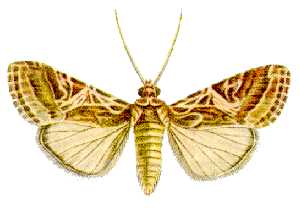Spodoptera litura
Spodoptera litura
Spodoptera litura, commonly known as the tobacco cutworm or cotton leafworm, is a species of moth in the family Noctuidae. It is a significant agricultural pest, affecting a wide range of crops in tropical and subtropical regions.
Description[edit | edit source]
The adult moth has a wingspan of approximately 30-38 mm. The forewings are brown with distinctive white markings, while the hindwings are white with brown margins. The larvae, or caterpillars, are greenish to brown with dark longitudinal stripes and can grow up to 45 mm in length.
Life Cycle[edit | edit source]
The life cycle of Spodoptera litura includes four stages: egg, larva, pupa, and adult. Females lay clusters of eggs on the underside of leaves. The larvae go through several instars before pupating in the soil. The entire life cycle can be completed in about 30-40 days, depending on environmental conditions.
Distribution[edit | edit source]
Spodoptera litura is widely distributed in Asia, Africa, and Oceania. It thrives in warm climates and is particularly prevalent in regions with intensive agriculture.
Host Plants[edit | edit source]
This species is highly polyphagous, feeding on over 120 different plant species. Major host plants include tobacco, cotton, soybean, groundnut, tomato, and various vegetables and ornamental plants.
Economic Impact[edit | edit source]
Spodoptera litura is a major pest in agriculture due to its wide host range and ability to cause significant crop damage. The larvae feed on leaves, stems, and fruits, leading to reduced yield and quality. Control measures include the use of insecticides, biological control agents, and cultural practices.
Management Strategies[edit | edit source]
Effective management of Spodoptera litura involves an integrated pest management (IPM) approach, which includes:
- Monitoring and early detection
- Use of resistant crop varieties
- Biological control using natural enemies such as parasitoids and predators
- Chemical control with selective insecticides
- Cultural practices like crop rotation and intercropping
Research and Development[edit | edit source]
Ongoing research aims to develop more sustainable and effective control methods, including the use of genetically modified crops and pheromone traps.
See Also[edit | edit source]
References[edit | edit source]
Search WikiMD
Ad.Tired of being Overweight? Try W8MD's physician weight loss program.
Semaglutide (Ozempic / Wegovy and Tirzepatide (Mounjaro / Zepbound) available.
Advertise on WikiMD
|
WikiMD's Wellness Encyclopedia |
| Let Food Be Thy Medicine Medicine Thy Food - Hippocrates |
Translate this page: - East Asian
中文,
日本,
한국어,
South Asian
हिन्दी,
தமிழ்,
తెలుగు,
Urdu,
ಕನ್ನಡ,
Southeast Asian
Indonesian,
Vietnamese,
Thai,
မြန်မာဘာသာ,
বাংলা
European
español,
Deutsch,
français,
Greek,
português do Brasil,
polski,
română,
русский,
Nederlands,
norsk,
svenska,
suomi,
Italian
Middle Eastern & African
عربى,
Turkish,
Persian,
Hebrew,
Afrikaans,
isiZulu,
Kiswahili,
Other
Bulgarian,
Hungarian,
Czech,
Swedish,
മലയാളം,
मराठी,
ਪੰਜਾਬੀ,
ગુજરાતી,
Portuguese,
Ukrainian
Medical Disclaimer: WikiMD is not a substitute for professional medical advice. The information on WikiMD is provided as an information resource only, may be incorrect, outdated or misleading, and is not to be used or relied on for any diagnostic or treatment purposes. Please consult your health care provider before making any healthcare decisions or for guidance about a specific medical condition. WikiMD expressly disclaims responsibility, and shall have no liability, for any damages, loss, injury, or liability whatsoever suffered as a result of your reliance on the information contained in this site. By visiting this site you agree to the foregoing terms and conditions, which may from time to time be changed or supplemented by WikiMD. If you do not agree to the foregoing terms and conditions, you should not enter or use this site. See full disclaimer.
Credits:Most images are courtesy of Wikimedia commons, and templates Wikipedia, licensed under CC BY SA or similar.
Contributors: Prab R. Tumpati, MD

